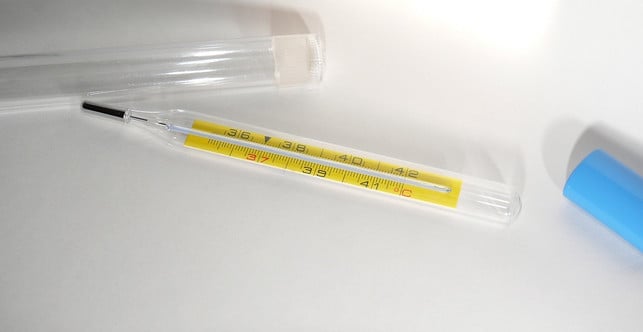
There are many different ways to measure fever. Here you can find out where you can measure your fever, which thermometers are suitable for this purpose and which temperature range is considered a fever.
![]()
Colds are not uncommon, especially in the cold season. But sometimes it’s not just a simple runny nose or cough: If you’re sick, you’ll usually have to take a grace period when you have a fever. But when does an elevated temperature actually count as a fever? And what is the most accurate way to measure fever? You will find out all about this in this article. We will explain to you in detail how you should correctly measure your temperature and which thermometers are best suited for this purpose.
At what temperature is it considered a fever?

Fever is the body’s reaction to a variety of causes, such as infectious diseases. In this case, the body increases its temperature as this increases the activity of immune cells. The body’s normal temperature is around 37 degrees Celsius.
The temperature at which fever is considered varies slightly from source to source. But according to the Pharmacy Review, the guideline is 38.2 degrees. This value applies when the temperature is measured rectally and varies depending on age:
-
Fever in adults: From 38.2 degrees Celsius
-
For children: From 38.5 degrees Celsius
-
For infants under three months: From 38 degrees Celsius
On the other hand, a temperature measured rectally between 37.6 and 38.4 degrees is considered to be an elevated temperature, depending on age. In very rare cases, body temperature can rise above 40 degrees (hyperpyrexia). This is a very high fever and you should see a doctor immediately.
Which places are suitable for taking your temperature?

There are several parts of the body where you can take your temperature. However, they are not all equally suitable. To get a first impression, it’s a good idea to feel the temperature with your hand on your forehead and, if necessary, compare it with the forehead temperature of others.
These places are suitable for accurately measuring your temperature:
- In the anus: Rectal measurement is considered the most accurate.
- In the mouth: Here you place the thermometer under the tongue in one of the depressions to the right and left of the root of the tongue. With this method of taking your temperature, it is important that you have not consumed any cold food or drinks for at least 30 minutes beforehand. The measurement result is about 0.3-0.5 degrees Celsius below the real value.
- In the armpit: The measurement here is quite inaccurate. The value you measure here can be up to two degrees Celsius below your real body temperature.
- In the ear: There are special ear thermometers for measuring in the ear (available online, for example from Amazon), more on that later. If you do this measurement correctly, you will get very accurate results. However, it must not be used on babies.
- On the forehead: There are also special thermometers for accurately measuring the temperature on the forehead (also available on Amazon). However, these measurements can also differ from the actual temperature by up to two degrees Celsius and are therefore quite inaccurate.
Which clinical thermometers are there and how good are they?

There are different types of thermometers, all of which have their advantages and disadvantages. Which device is suitable depends on where you want to measure your temperature. Generally there are contact thermometers that have a metal contact at the tip. It must come into direct contact with the part of the body where you want to take your temperature.
There are also thermometers that do not require direct contact with the body. They determine the temperature using infrared radiation.
These are the three most common types of thermometers:
- In the past, analog contact thermometers with a mercury column were used. Since mercury is very toxic, these thermometers have no longer been approved for private use across the EU since 2009. Instead, the mercury is replaced by gallium. If you want to use such a thermometer to take your temperature, you should know that it is a “peak thermometer”. This means that the level of the metal column remains at the highest measured value after a measurement. If you want to use the thermometer again, you will need to shake it to lower the level. The analog clinical thermometers are comparatively inexpensive and very accurate at prices under ten euros. Another advantage is that they work without a battery. However, the measuring process with them takes quite a long time and there is no signal at the end of the measurement. In addition, gallium is a very rare element and its extraction is complex and energy-intensive.
- Digital contact thermometers are particularly widespread today. They cost the same as analog thermometers and are also very accurate. They also have the advantage over analogue thermometers in that they are easier to use. The measuring process doesn’t take long and the device informs you of the end of the measurement using an acoustic signal.
- Infrared technology is most often used in ear thermometers, but also in thermometers that measure forehead temperature. Ear thermometers are becoming increasingly popular in the medical field because they are very fast and accurate. The disadvantage, however, is that good ear thermometers are more expensive than the previously mentioned contact thermometers. When used correctly, they are very accurate when taking temperatures.
When should you have a fever checked by a doctor?

You don’t always need to seek medical treatment immediately if you have a fever. If you have a mild fever or high temperature in adults and the affected person otherwise feels reasonably well, you can wait a few days to see if the condition improves on its own. But things are different with children or with a high fever.
In these cases, according to the Pharmacy Review, you should see a doctor immediately:
- If your baby has a temperature above 38 degrees Celsius up to three months.
- If an older baby or toddler has a fever for more than a day.
- Older children and adults should see a doctor if the fever persists for more than three days or the temperature rises to 40 degrees Celsius.
- If other symptoms of illness (vomiting, diarrhea, stiff neck, abdominal pain, skin rashes) occur.
- If the sick person has a febrile seizure, you should call 911 immediately.
- If you get a fever after a stay abroad and also have other symptoms of illness, it is also a good idea to seek medical advice.
Edited by Jennifer Watzek
Read more on Techzle\.com:
- Willow bark: home remedy for fever, pain and other complaints
- From vitamin C to nasal spray: 11 cold myths put to the test
- 8 common cold mistakes you can easily avoid
** marked with ** or orange underlined Links to sources of supply are partly partner links: If you buy here, you are actively supporting Techzle\.com, because we then receive a small part of the sales proceeds. More info.